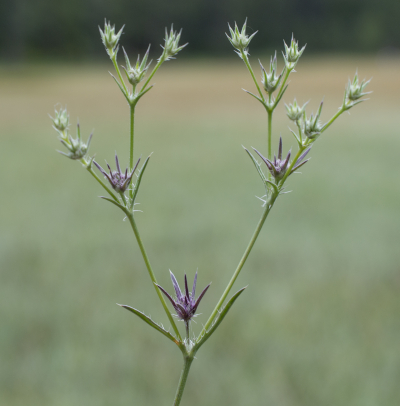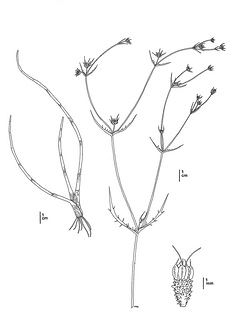(Eryngium constancei)
 Eryngium constancei. CDFW photo by Jeb Bjerke.
Eryngium constancei. CDFW photo by Jeb Bjerke.
 Eryngium constancei. CDFW illustration by Mary Ann Showers. (Click to enlarge)
Eryngium constancei. CDFW illustration by Mary Ann Showers. (Click to enlarge)
Loch Lomond button-celery (Eryngium constancei) is a California endangered plant species, which means that killing or possessing the plant is prohibited by the California Endangered Species Act (CESA). The species is also listed as endangered under the federal Endangered Species Act. Loch Lomond button-celery is a spiny perennial vernal pool plant with inconspicuous flowers that typically appear between April and June. There are four occurrences of the species listed in CDFW’s California Natural Diversity Database (CNDDB) and one additional population has been reported in the Eryngium constancei (PDF)(Loch Lomond Coyote-Thistle) 5-Year Review, published by the U.S. Fish and Wildlife Service (USFWS) in 2009. One of the populations listed in the CNDDB occurs on CDFW’s Loch Lomond Vernal Pool Ecological Reserve in Lake County. Two of the other three populations recorded in the CNDDB are on private property in Lake and Sonoma Counties, and the third population's exact location is unknown, but it is mapped along Loch Lomond Road in Lake County. The fifth population, which is not recorded in the CNDDB, is in an unnamed pool near Cobb in Lake County.
Although the population of Loch Lomond button-celery at the Loch Lomond Vernal Pool Ecological Reserve is protected from direct changes in land use, it is still threatened by routine highway maintenance, trash dumping and, to a smaller degree, fence vandalism, vehicle trespass, and trampling. In addition, invasive non-native pennyroyal (Mentha pulegium) and other invasive plant species are present in and around the vernal pool at Loch Lomond Ecological Reserve and may also threaten the Loch Lomond button-celery population. A Draft Management Plan for the Loch Lomond Vernal Pool Ecological Reserve (PDF) has been prepared and should be implemented. As part of the management plan, CDFW has implemented a monitoring for adaptive management plan for this population to monitor population trends and possible impacts to the population from pennyroyal and other threats. The other recorded populations of the species all remain unprotected, and could be impacted by proposed agricultural conversion, development of a reservoir, or other activities proposed in the future. Changes in hydrology from road runoff, drainage ditches, culverts, diversion of springs, and larger-scale alterations from commercial development or timber harvesting also threaten populations of Loch Lomond button-celery. In addition, plants with limited distributions, such as Loch Lomond button-celery, are at a greater risk of extinction from unpredictable events, and climate change could also negatively affect the species in the future.
To protect Loch Lomond button-celery from extinction, vernal pool habitat supporting the species should be protected through conservation easements or the purchase of fee title. In addition, all known populations of the species should be surveyed to determine their current status, and a standardized monitoring protocol should be established. Seeds should also be collected from all of the remaining populations for long-term conservation storage. Further recommendations can also be found in the Recovery Plan for Vernal Pool Ecosystems of California and Southern Oregon(opens in new tab), published by the USFWS in 2005 and in the Eryngium constancei (Loch Lomond Coyote-Thistle) 5-Year Review (PDF) (USFWS 2009).
CDFW may issue permits for Loch Lomond button-celery pursuant to CESA, and you can learn more about the California laws protecting Loch Lomond button-celery and other California native plants. Populations of Loch Lomond button-celery occur in CDFW’s North Central Region and Bay Delta Region. More information is also available from the U.S. Fish and Wildlife Service’s Species Profile for Loch Lomond Coyote Thistle.
Updated 11/29/18